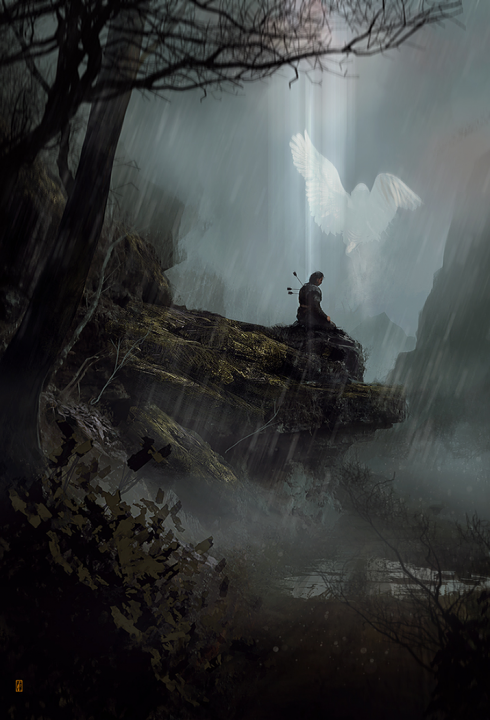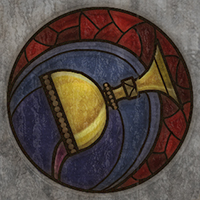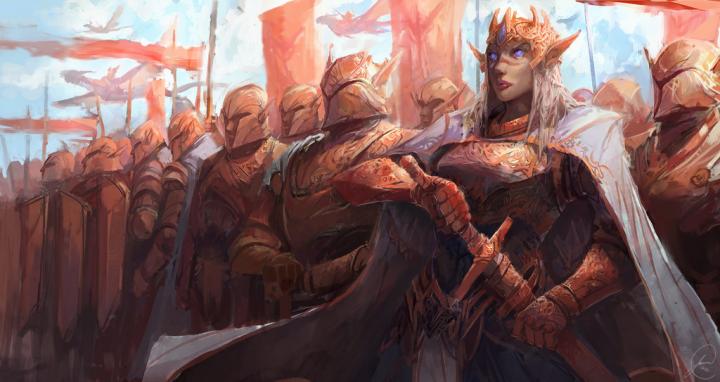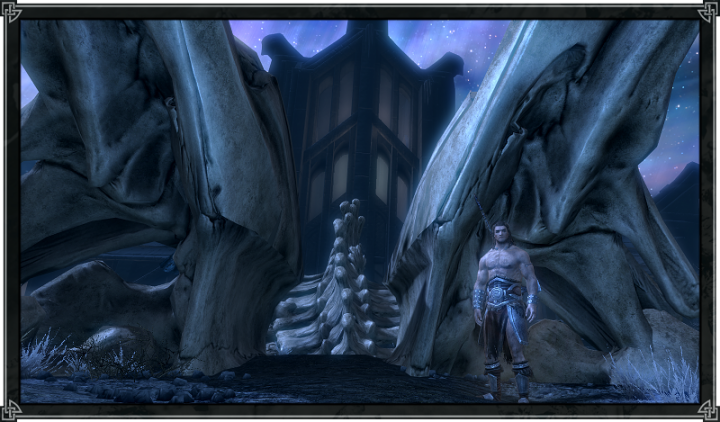Loss. Such a small word, briefly said, belying the resevoir of deep feelings and emotion we are left with after experiencing it. After the enomority of this small word hits us and once the shock of it subsides, there is little to dam the rising tide of tears that threaten to drown us. Then, like Kyne, we cry for all that has been lost, all that will never be, all the memories we have left, and all those which have been robbed from us. In time, Akatosh's domain shared by Arkay, the tears of loss may turn bittersweet as we treasure the memories we do have, mourn the life lost, while appreciating that which remains.
Memory and water both play a part when coping with grief and coming to terms with death.
Arkay of the Eight Divines is, in origin, a fusion of aspects of the Elven deity Xarxes with those of the primal Atmoran death-god Orkey. My new translation of the Death-Song and its (formerly ill-understood) "plea for soul-guidance" passages make it clear that the psychopomp being addressed possesses attributes of both the Elven and Atmoran deities. ~ Tu'whacca, Arkay, Xarxes
When examining the relationship between death, memory and water, there are a few examples which stand out besides Kyne who "made the first rain at his (Shor's) sundering."
Of these, it is Stendarr and Tsun who I would like to examine here, and in so doing link them to the god of death, Arkay.

 We know Stendarr the Steadfast as the god of mercy, charity, justice, and righteous rule by might and merciful forbearance. We recognise his symbols of the goblet and the horn pouring liquid, and we know that Jone, the Little Moon God we call Secunda is also known as "Stendarr's Sorrow."
We know Stendarr the Steadfast as the god of mercy, charity, justice, and righteous rule by might and merciful forbearance. We recognise his symbols of the goblet and the horn pouring liquid, and we know that Jone, the Little Moon God we call Secunda is also known as "Stendarr's Sorrow."
In the Nordic Pantheon, Stendarr is Stuhn the Shield-Thane of Shor, he who showed Men how to take, and the benefits of taking, prisoners of war = Nord mercy.
During the events of TES V: Skyrim we meet Stuhn's brother, Tsun, guardian of the Whalebone Bridge and winnower of souls in Sovngarde:
"The Whalebone Bridge he bade me guard and winnow all those souls whose heroic end sent them here, to Shor's lofty hall where welcome, well earned, awaits those I judge fit to join that fellowship of honor." ~ Tsun's dialogue.
The out-of-game book Shor, Son of Shor - possibly my favourite oog source as it shows the circular nature of Nord mythology and illustrates the Kalpic cycle - depicts these brothers in a different way, and we can see by their introduction in the tale how they merge between themselves:
"Our chieftain loses heart," Dibella said, Bed-Wife of Shor, hefting another body onto the corpse pile some of us were making, "And so goes to the speak to one that has none anymore. Mirrors, indeed, and in that I see no logic."
"Tsun took her by the hair, for he was angered by her words and heavy with lust. He was a berserker despite his high station, and love followed battle to his kind. "You weren't made for that kind of thinking," Stuhn said, dragging Dibella towards a whaleskin tent, "Jhunal was. And no one should be speaking to him now." Tsun eyed the Clever Man who had heard him. "Logic is dangerous in these days, in this place. To live in Skyrim is to change your mind ten times a day lest it freeze to death. And we can have none of that now." ~ Shor, Son of Shor
The story goes on, telling in its own way the saga of Convention and the Sundering in which it is Shor himself who removes his own heart, like Shor before him:
And he took the third by vomiting his own heart into the circle like a hammerclap, guarding his wraith in the manner of his father and roaring at the other tribes, "Again we fight for our petty placements in this House, in the Around Us, and all it will amount to is a helix of ghosts like mine now spit into the world below where we fight again! I can already feel the war below us starting, and yet you have not yet thrown your first spears even here!" We took our leave of the House and would never reconvene again in this age. ~ Shor, Son of Shor
 Yep, Trinimac, Auriel's greatest knight and an ada who in some places was more popular than Auriel, was a lady.
Yep, Trinimac, Auriel's greatest knight and an ada who in some places was more popular than Auriel, was a lady.
The next part of tale contains the missing link figure, Trinimac. Trinimac was one of the strongest Aldmeri et'ada, and according to legend it was this knight who knocked down Lorkhan in front of his army and ripped out his heart. It is interesting, then, as we examine the relationships between these gods that one half of Lorkhan/Shor's "flesh divinity" be called "Stendarr's Sorrow." Trinimac here on out in the story merges with Tsun and Stuhn so as to be the Aldmeri version of the two berserker brothers:
"The Moot looked to the tribe of Ald son of Ald but he would break no oath of the Pact, saying "Shor has paid ransom now three times for the the sins we accused him of, and by that we will hold him as dead and shake not our spears against him or his kin. Of the below he speaks, he is confused by it, for under us is only a prologue, and under that still is only a scribe that hasn't written anything yet. Shor as always forgets the above, and condemns himself and any other who would believe him into this cycle." Ald's shield thane Trinimac shook his head at this, for he was akin to Tsun and did not care much for logic-talk as much as he did only for his own standing. He told his chieftain that these words had been said before and Ald only sighed and said, "Yes, and always they will be ignored. As for the war you crave, bold Trinimac, and all of you assembled, do not worry. A spear will be thrown into this soon, from Shor's own tribe, and the House of We will be allowed our vengeance." ~ Shor, Son of Shor
That kinship plays out literally in the next part, for where before it was Tsun shifting into Stuhn, now it is Trinimac taking Tsun's place:
Trinimac left Dibella in his tent as we assembled, and he had not touched her, frozen in the manner of the Nords when we are unsure of our true place, and asked his brother to rearm him. Stuhn was confused for a moment, thinking this an odd shift... ~ Shor, Son of Shor
To summarise, the book is indicating that Trinimac is Tsun, who in turn, is Stuhn. The name Trinimac is threefold, hence the TRI. If Tsun and Stuhn can be considered as possible two of the three, it is time now to look at the third.
The transformation of Trinimac is known to us through the myth of Boethiah eating and deficating Auriel's Greatest Knight, the feces being the new Daedric Prince, Malacath. In Nordic mythology, Malacath is known as Orkey:
God of mortality, Orkey combines aspects of Mauloch and Arkay. He is a "loan-god" for the Nords, who seem to have taken up his worship during Aldmeri rule of Atmora. ~ Varieties of Faith: Nords
Xarxes is the Aldmeri god of ancestry and scret knowledge, the scribe of Auriel, and so to return to the very first quote above from Arkay, Tu'whacca, Xarxes, we can see that Orkey, Arkay and Xarxes are the aspects of the same deity:
To come to the point, I believe I may well finally have enough evidence to confirm Sedulus' speculative Theory of Arkayn Convergence. Most of my readers will doubtless be familiar with Sedulus' proposal that the Arkay of the Eight Divines is, in origin, a fusion of aspects of the Elven deity Xarxes with those of the primal Atmoran death-god Orkey. My new translation of the Death-Song and its (formerly ill-understood) "plea for soul-guidance" passages make it clear that the psychopomp being addressed possesses attributes of both the Elven and Atmoran deities. And, once the proper vowel-shift is applied, what is the name of this god?
"To-Arcka."
Which brings us, inevitably, to the Yokudan deity Tu'whacca. How long he was worshiped in that name by the human tribes of Yokuda is now unknowable, as all our race's records were lost in the cataclysm that sank the archipelago. But as even old Phrastus had the wits to note, it cannot be a coincidence that Tu'whacca performs the same functions for the Redguards that Arkay and Xarxes do for Tamrielic Men and Mer. Are these gods really separate and distinct deities, or are they all aspects of the same deity, worshiped under different names in different cultures?
You must seek the answer elsewhere, for that is where scholarship ends and theology begins. ~ Tu'whacca, Arkay, Xarxes

To leave Lady Cinnabar's questions for the reader to answer, I return at last to the link between water, death, and memory. The Transformation of Trinimac is an allegorical myth, not to be taken literally. However, in a world in which myth becomes fact and new gods are formed from the combinations of their various cultural aspects through belief, a transformation, literal or not, still creates something new.
Death is a transformation, the final stage of life in which the soul travels to the great unknown. In Nordic myth, this place is Sovngarde, and to get to it heroes must face the trial of Tsun before crossing the waters of the Underworld, an act reminiscent of many of our own Underworld myths. Those who pass Tsun's test are permmited into Shor's Hall, while those who fail are returned to Dreamsleeve river where their memory is washed away and they return to Arkay's Wheel to live a new life.
If we look at the Transformation of Trinimac in that light, the progress of the soul mirrors the story of Stuhn, Tsun, and Trinimac; each of whom are part of the god of the cycle of birth and death, Arkay.
Around them rose a garden of slender trees, and wound about the trunks were vines festooned with lily like flowers. A multitude of spheres moved, deep in the colorless sky, as distant and pale as moons. [Attrebus] heard birds chirping, but it was a doleful sound, as if something with a vague memory of having been a bird was trying to reproduce sounds it no longer felt. Malacath appears to feel some sort of sadness towards this locale, reproducing it in his realm. He describes it as a shadow of a garden, this echo of something that once was. ~ Lord of Souls Lore Notes
Memories flow into the water of the Dreamsleeve but are never truly lost. Arkay, son of Akatosh and the scribe of Auriel, Xarxes keeps and records each one after they face the trial of his dead aspect, Tsun. Stendarr the merciful watches on in sorrow.
Loss. Such a small word, briefly said, belying the resevoir of deep feelings and emotion we are left with after experiencing it. After the enomority of this small word hits us and once the shock of it subsides, there is little to dam the rising tide of tears that threaten to drown us. Then, like Kyne, we cry for all that has been lost, all that will never be, all the memories we have left, and all those which have been robbed from us. In time, Akatosh's domain shared by Arkay, the tears of loss may turn bittersweet as we treasure the memories we do have, mourn the life lost, while appreciating that which remains.
Memory and water both play a part when coping with grief and coming to terms with death.
Arkay of the Eight Divines is, in origin, a fusion of aspects of the Elven deity Xarxes with those of the primal Atmoran death-god Orkey. My new translation of the Death-Song and its (formerly ill-understood) "plea for soul-guidance" passages make it clear that the psychopomp being addressed possesses attributes of both the Elven and Atmoran deities. ~ Tu'whacca, Arkay, Xarxes
When examining the relationship between death, memory and water, there are a few examples which stand out besides Kyne who "made the first rain at his (Shor's) sundering."
Of these, it is Stendarr and Tsun who I would like to examine here, and in so doing link them to the god of death, Arkay.

 We know Stendarr the Steadfast as the god of mercy, charity, justice, and righteous rule by might and merciful forbearance. We recognise his symbols of the goblet and the horn pouring liquid, and we know that Jone, the Little Moon God we call Secunda is also known as "Stendarr's Sorrow."
We know Stendarr the Steadfast as the god of mercy, charity, justice, and righteous rule by might and merciful forbearance. We recognise his symbols of the goblet and the horn pouring liquid, and we know that Jone, the Little Moon God we call Secunda is also known as "Stendarr's Sorrow."
In the Nordic Pantheon, Stendarr is Stuhn the Shield-Thane of Shor, he who showed Men how to take, and the benefits of taking, prisoners of war = Nord mercy.
During the events of TES V: Skyrim we meet Stuhn's brother, Tsun, guardian of the Whalebone Bridge and winnower of souls in Sovngarde:
"The Whalebone Bridge he bade me guard and winnow all those souls whose heroic end sent them here, to Shor's lofty hall where welcome, well earned, awaits those I judge fit to join that fellowship of honor." ~ Tsun's dialogue.
The out-of-game book Shor, Son of Shor - possibly my favourite oog source as it shows the circular nature of Nord mythology and illustrates the Kalpic cycle - depicts these brothers in a different way, and we can see by their introduction in the tale how they merge between themselves:
"Our chieftain loses heart," Dibella said, Bed-Wife of Shor, hefting another body onto the corpse pile some of us were making, "And so goes to the speak to one that has none anymore. Mirrors, indeed, and in that I see no logic."
"Tsun took her by the hair, for he was angered by her words and heavy with lust. He was a berserker despite his high station, and love followed battle to his kind. "You weren't made for that kind of thinking," Stuhn said, dragging Dibella towards a whaleskin tent, "Jhunal was. And no one should be speaking to him now." Tsun eyed the Clever Man who had heard him. "Logic is dangerous in these days, in this place. To live in Skyrim is to change your mind ten times a day lest it freeze to death. And we can have none of that now." ~ Shor, Son of Shor
The story goes on, telling in its own way the saga of Convention and the Sundering in which it is Shor himself who removes his own heart, like Shor before him:
And he took the third by vomiting his own heart into the circle like a hammerclap, guarding his wraith in the manner of his father and roaring at the other tribes, "Again we fight for our petty placements in this House, in the Around Us, and all it will amount to is a helix of ghosts like mine now spit into the world below where we fight again! I can already feel the war below us starting, and yet you have not yet thrown your first spears even here!" We took our leave of the House and would never reconvene again in this age. ~ Shor, Son of Shor
 Yep, Trinimac, Auriel's greatest knight and an ada who in some places was more popular than Auriel, was a lady.
Yep, Trinimac, Auriel's greatest knight and an ada who in some places was more popular than Auriel, was a lady.
The next part of tale contains the missing link figure, Trinimac. Trinimac was one of the strongest Aldmeri et'ada, and according to legend it was this knight who knocked down Lorkhan in front of his army and ripped out his heart. It is interesting, then, as we examine the relationships between these gods that one half of Lorkhan/Shor's "flesh divinity" be called "Stendarr's Sorrow." Trinimac here on out in the story merges with Tsun and Stuhn so as to be the Aldmeri version of the two berserker brothers:
"The Moot looked to the tribe of Ald son of Ald but he would break no oath of the Pact, saying "Shor has paid ransom now three times for the the sins we accused him of, and by that we will hold him as dead and shake not our spears against him or his kin. Of the below he speaks, he is confused by it, for under us is only a prologue, and under that still is only a scribe that hasn't written anything yet. Shor as always forgets the above, and condemns himself and any other who would believe him into this cycle." Ald's shield thane Trinimac shook his head at this, for he was akin to Tsun and did not care much for logic-talk as much as he did only for his own standing. He told his chieftain that these words had been said before and Ald only sighed and said, "Yes, and always they will be ignored. As for the war you crave, bold Trinimac, and all of you assembled, do not worry. A spear will be thrown into this soon, from Shor's own tribe, and the House of We will be allowed our vengeance." ~ Shor, Son of Shor
That kinship plays out literally in the next part, for where before it was Tsun shifting into Stuhn, now it is Trinimac taking Tsun's place:
Trinimac left Dibella in his tent as we assembled, and he had not touched her, frozen in the manner of the Nords when we are unsure of our true place, and asked his brother to rearm him. Stuhn was confused for a moment, thinking this an odd shift... ~ Shor, Son of Shor
To summarise, the book is indicating that Trinimac is Tsun, who in turn, is Stuhn. The name Trinimac is threefold, hence the TRI. If Tsun and Stuhn can be considered as possible two of the three, it is time now to look at the third.
The transformation of Trinimac is known to us through the myth of Boethiah eating and deficating Auriel's Greatest Knight, the feces being the new Daedric Prince, Malacath. In Nordic mythology, Malacath is known as Orkey:
God of mortality, Orkey combines aspects of Mauloch and Arkay. He is a "loan-god" for the Nords, who seem to have taken up his worship during Aldmeri rule of Atmora. ~ Varieties of Faith: Nords
Xarxes is the Aldmeri god of ancestry and scret knowledge, the scribe of Auriel, and so to return to the very first quote above from Arkay, Tu'whacca, Xarxes, we can see that Orkey, Arkay and Xarxes are the aspects of the same deity:
To come to the point, I believe I may well finally have enough evidence to confirm Sedulus' speculative Theory of Arkayn Convergence. Most of my readers will doubtless be familiar with Sedulus' proposal that the Arkay of the Eight Divines is, in origin, a fusion of aspects of the Elven deity Xarxes with those of the primal Atmoran death-god Orkey. My new translation of the Death-Song and its (formerly ill-understood) "plea for soul-guidance" passages make it clear that the psychopomp being addressed possesses attributes of both the Elven and Atmoran deities. And, once the proper vowel-shift is applied, what is the name of this god?
"To-Arcka."
Which brings us, inevitably, to the Yokudan deity Tu'whacca. How long he was worshiped in that name by the human tribes of Yokuda is now unknowable, as all our race's records were lost in the cataclysm that sank the archipelago. But as even old Phrastus had the wits to note, it cannot be a coincidence that Tu'whacca performs the same functions for the Redguards that Arkay and Xarxes do for Tamrielic Men and Mer. Are these gods really separate and distinct deities, or are they all aspects of the same deity, worshiped under different names in different cultures?
You must seek the answer elsewhere, for that is where scholarship ends and theology begins. ~ Tu'whacca, Arkay, Xarxes

To leave Lady Cinnabar's questions for the reader to answer, I return at last to the link between water, death, and memory. The Transformation of Trinimac is an allegorical myth, not to be taken literally. However, in a world in which myth becomes fact and new gods are formed from the combinations of their various cultural aspects through belief, a transformation, literal or not, still creates something new.
Death is a transformation, the final stage of life in which the soul travels to the great unknown. In Nordic myth, this place is Sovngarde, and to get to it heroes must face the trial of Tsun before crossing the waters of the Underworld, an act reminiscent of many of our own Underworld myths. Those who pass Tsun's test are permmited into Shor's Hall, while those who fail are returned to Dreamsleeve river where their memory is washed away and they return to Arkay's Wheel to live a new life.
If we look at the Transformation of Trinimac in that light, the progress of the soul mirrors the story of Stuhn, Tsun, and Trinimac; each of whom are part of the god of the cycle of birth and death, Arkay.
Around them rose a garden of slender trees, and wound about the trunks were vines festooned with lily like flowers. A multitude of spheres moved, deep in the colorless sky, as distant and pale as moons. [Attrebus] heard birds chirping, but it was a doleful sound, as if something with a vague memory of having been a bird was trying to reproduce sounds it no longer felt. Malacath appears to feel some sort of sadness towards this locale, reproducing it in his realm. He describes it as a shadow of a garden, this echo of something that once was. ~ Lord of Souls Lore Notes
Memories flow into the water of the Dreamsleeve but are never truly lost. Arkay, son of Akatosh and the scribe of Auriel, Xarxes keeps and records each one after they face the trial of his dead aspect, Tsun. Stendarr the merciful watches on in sorrow.



 We know Stendarr the Steadfast as the god of mercy, charity, justice, and righteous rule by might and merciful forbearance. We recognise his symbols of the goblet and the horn pouring liquid, and we know that Jone, the Little Moon God we call Secunda is also known as "Stendarr's Sorrow."
We know Stendarr the Steadfast as the god of mercy, charity, justice, and righteous rule by might and merciful forbearance. We recognise his symbols of the goblet and the horn pouring liquid, and we know that Jone, the Little Moon God we call Secunda is also known as "Stendarr's Sorrow." 



